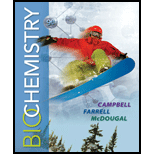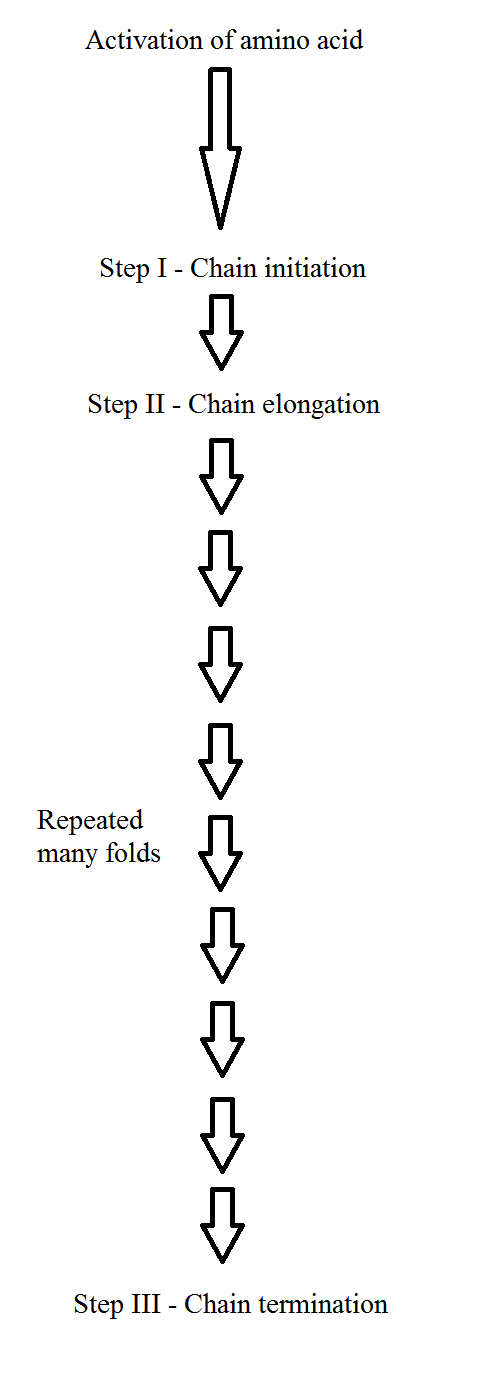
Concept explainers
RECALL Prepare a flow chart showing the stages of protein synthesis.
Interpretation:
A flow chart representing various stages of protein biosynthesis is to be prepared.
Concept introduction:
Proteins are large macromolecules, which consist of long sequences of amino acid residues. They are involved in a number of different biochemical processes in an organism.
They mostly differ in their structure and activity due to the arrangement of amino acid residues that is governed by their gene makeup.
Answer to Problem 1RE
Solution:

Explanation of Solution
Biosynthesis of protein is a complicated process that requires messenger and transfer RNA (mRNA and tRNA), ribosomes, and various protein factors. Ribosomes are the primary location for the biosynthesis of protein, to which the mRNA and tRNA are attached. The mRNA and tRNA are crucial for the correct arrangement of amino acids in the elongating chain.
The amino acid must be activated prior to being incorporated in the protein chain. The activation of amino acids requires tRNA and aminoacyl-tRNA synthetases (a group of specific enzymes). The amino acid residues get attached covalently to the tRNA forming aminoacyl-tRNA. The actual synthesis of polypeptide sequences takes place in three steps (chain initiation, chain elongation, and chain termination).
In the chain initiation step, the primary aminoacyl-tRNA gets attached to mRNA at a point that codes the initiation of polypeptide biosynthesis. The mRNA is attached with the ribosome, forming a complex. The subsequent aminoacyl-tRNA then makes a complex with the complex of ribosome and mRNA. The binding position for the subsequent aminoacyl-tRNA is adjacent to the primary aminoacyl-tRNA. Now, in the chain elongation step, formation of a peptide bond takes place between the amino acids. This process recurs until the polypeptide chain is accomplished. At last, in the chain termination step, the newly synthesized protein is released from the ribosomes.
The protein molecules are long chains of amino acids, the information for which is stored in the genetic code.
Want to see more full solutions like this?
Chapter 12 Solutions
Owlv2,1 Term Printed Access Card For Campbell/farrell/mcdougal's Biochemistry, 9th
- Draw the reaction between sphingosine and arachidonic acid. Draw out the full structures.arrow_forwardDraw both cis and trans oleic acid. Explain why cis-oleic acid has a melting point of 13.4°C and trans-oleic acid has a melting point of 44.5°C.arrow_forwardDraw the full structure of the mixed triacylglycerol formed by the reaction of glycerol and the fatty acids arachidic, lauric and trans-palmitoleic. Draw the line structure.arrow_forward
- Draw out the structure for lycopene and label each isoprene unit. "Where is lycopene found in nature and what health benefits does it provide?arrow_forwardWhat does it mean to be an essential fatty acid? What are the essential fatty acids?arrow_forwardCompare and contrast primary and secondary active transport mechanisms in terms of energy utilisation and efficiency. Provide examples of each and discuss their physiological significance in maintaining ionic balance and nutrient uptake. Rubric Understanding the key concepts (clearly and accurately explains primary and secondary active transport mechanisms, showing a deep understanding of their roles) Energy utilisation analysis ( thoroughly compares energy utilisation in primary and secondary transport with specific and relevant examples Efficiency discussion Use of examples (provides relevant and accurate examples (e.g sodium potassium pump, SGLT1) with clear links to physiological significance. Clarity and structure (presents ideas logically and cohesively with clear organisation and smooth transition between sections)arrow_forward
- 9. Which one of the compounds below is the major organic product obtained from the following reaction sequence, starting with ethyl acetoacetate? 요요. 1. NaOCH2CH3 CH3CH2OH 1. NaOH, H₂O 2. H3O+ 3. A OCH2CH3 2. ethyl acetoacetate ii A 3. H3O+ OH B C D Earrow_forward7. Only one of the following ketones cannot be made via an acetoacetic ester synthesis. Which one is it? Ph کہ A B C D Earrow_forward2. Which one is the major organic product obtained from the following reaction sequence? HO A OH 1. NaOEt, EtOH 1. LiAlH4 EtO OEt 2. H3O+ 2. H3O+ OH B OH OH C -OH HO -OH OH D E .CO₂Etarrow_forward
- what is a protein that contains a b-sheet and how does the secondary structure contributes to the overall function of the protein.arrow_forwarddraw and annotate a b-sheet and lable the hydrogen bonding. what is an example that contains the b-sheet and how the secondary structure contributes to the overall function of your example protein.arrow_forwardFour distinct classes of interactions (inter and intramolecular forces) contribute to a protein's tertiary and quaternary structures. Name the interaction then describe the amino acids that can form this type of interaction. Draw and annotate a diagram of the interaction between two amino acids.arrow_forward
 BiochemistryBiochemistryISBN:9781305961135Author:Mary K. Campbell, Shawn O. Farrell, Owen M. McDougalPublisher:Cengage Learning
BiochemistryBiochemistryISBN:9781305961135Author:Mary K. Campbell, Shawn O. Farrell, Owen M. McDougalPublisher:Cengage Learning
